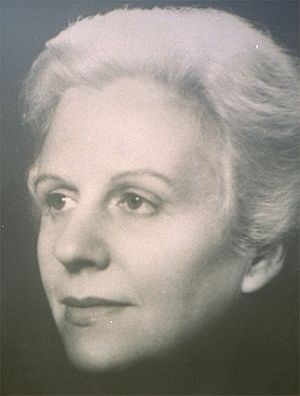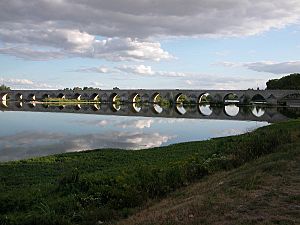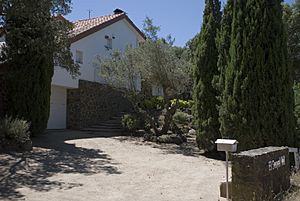Mercè Rodoreda facts for kids
Quick facts for kids
Mercè Rodoreda
|
|
|---|---|

Mercè Rodoreda
|
|
| Born | 10 October 1908 Barcelona, Catalonia, Spain |
| Died | 13 April 1983 (aged 74) Girona, Catalonia, Spain |
| Resting place | Romanyà de la Selva |
| Occupation | Novelist, Dramatist, Poet |
| Language | Catalan |
| Notable works | The Time of the Doves, Mirall trencat, Aloma |
| Notable awards | Premi d'Honor de les Lletres Catalanes (1980) Premi Joan Crexells de narrativa (1937) Mestre en Gai Saber (1949) |
| Partner | Armand Obiols |
Mercè Rodoreda i Gurguí (Catalan pronunciation: [məɾˈsɛ ruðuˈɾɛðə]; 10 October 1908 – 13 April 1983) was a Spanish novelist. She wrote her books in the Catalan language.
Many people consider her the most important Catalan writer of her time. Her books have been translated into over thirty languages. This shows how much her work has influenced other authors around the world.
She is also known as the most important Catalan female novelist after the Spanish Civil War. Her novel La plaça del diamant (which means 'The Diamond Square'), translated as The Time of the Doves (1962), is the most popular Catalan novel ever. Some experts even say it's one of the best novels published in Spain after the Civil War.
Contents
About Mercè Rodoreda's Life
Her Childhood (1908-1921)
Mercè Rosa Rodoreda i Gurguí was born on October 10, 1908, in Barcelona, Spain. Her parents, Andreu Rodoreda and Montserrat Gurguí, loved books and theater. They even took acting classes.
Because her family had money problems, Mercè had to leave school at age nine. She went to different schools from 1915 to 1920. Later, she studied only French and math at another academy.
Her grandfather, Pere Gurguí, was a big fan of the writer Jacint Verdaguer. He even had a monument to Verdaguer in his garden. Mercè's grandfather taught her a lot. He helped her love the Catalan language and flowers, which later appeared in her stories.
When she was only five, Mercè acted in a play called The Mysterious Jimmy Samson. Years later, she used this experience in one of her own stories. As a child, she read many classic Catalan writers, like Jacint Verdaguer and Ramon Llull. Her family's home was full of art and books.
On May 30, 1920, she acted in another play and read a poem. In 1921, her uncle Juan moved in with the family. He brought a more strict way of life. Mercè married him on her twentieth birthday, October 10, 1928. He was fourteen years older than her.
Her Youth and Early Writing (1921-1938)
After their wedding, Mercè and her husband went to Paris for their honeymoon. Then they settled in Barcelona. Her husband had lived in Argentina and returned with some money.
On July 23, 1929, their only son, Jordi, was born. After this, Mercè started writing to escape her boring married life. She began to think of writing as a job. She often wrote in a blue dovecote (a small house for doves) at her mother's house. This dovecote later inspired a famous part of her novel The Time of the Doves.
Starting Her Writing Career
In 1931, she took classes at the Dalmau Lyceum. There, she improved her language skills with Delfí Dalmau, a teacher who encouraged her writing. Dalmau admired Mercè and asked her to help with his book, Polémica, which was published in 1934.
In 1932, Mercè Rodoreda published her first novel, Am I an honored woman?. It didn't get much attention at first. She also wrote stories for newspapers. In 1933, she started working as a journalist for the magazine Clarisme. She wrote stories, interviews, and comments on different topics.
In 1934, she published her second book, What cannot be escaped. She also won an award for a story called "The little mermaid and the dolphin," which is now lost. A publisher named Joan Puig i Ferrater became interested in her work. He helped her publish her next novel, A day in the life of a man, in 1934. She also joined a group of writers called 'El Club de los Novelistas'.
From 1935 to 1939, she wrote sixteen children's stories for a newspaper. She also published stories in other important Catalan magazines. In 1936, she published her fourth novel, Crim. Later, she didn't like her first four novels, thinking they were not good enough.
During the Spanish Civil War
From 1937, Mercè worked as a Catalan language editor for the government's Propaganda office. There, she met other writers and made friends.
In 1937, she won the Joan Crexells Prize for her novel Aloma. That same year, she separated from her husband. In 1938, her fifth novel, Aloma, was published. This was the first book she truly accepted as her own. She even rewrote it later. Also in 1938, she traveled to Prague for a writers' conference.
Life in Exile (1938-1972)
On January 23, 1939, just before the end of the Spanish Civil War, Mercè fled Spain. She left her son with her mother, thinking she would return soon. She went to France with other writers, crossing the border into Northern Catalonia.
Living in Roissy-en-Brie
She arrived in Paris in February and then moved to Roissy-en-Brie, a town near the capital. She stayed in a castle that offered refuge to writers. She lived with other writers like Armand Obiols and Francesc Trabal. Mercè and Armand Obiols started a relationship there. This caused some problems among the exiled writers. Mercè wanted to write a book about this time, but she never did.
The start of World War II made life difficult. Some writers went to Latin America, but Mercè and Obiols stayed in France. They moved to a house on the outskirts of the city.
Escaping from the Nazi Troops
In June 1940, Mercè and other writers had to flee Paris because the German army was advancing. They tried to get a truck and a train, but couldn't. They had to walk south to cross the Loire River into an unoccupied area.
After twelve days, they found shelter on a farm. They finally crossed the Loire River through a destroyed town called Meung-sur-Loire. From there, they traveled further south to Limoges.
Life in Limoges and Bordeaux
In Limoges, Mercè lived in a small room. These were hard times. In June 1941, Armand Obiols was arrested and forced to work in a quarry. Mercè was alone until October. She worked hard to get him sent to Bordeaux, where conditions were better.
While Obiols was in Bordeaux, Mercè studied English. They saw each other only sometimes. In August 1943, Mercè moved to Bordeaux to be with Obiols. She worked long hours as a seamstress in a warehouse, which left her no time to write.
Returning to Paris
In September 1946, Mercè and Obiols moved back to Paris. They lived in an apartment in a lively area where many intellectuals met. This was her home for eight years.
In 1947, she stopped sewing and started working for the magazine Revista de Catalunya. She published stories there and also in magazines in Chile and Mexico.
From 1947 to 1953, Mercè had health problems, including a paralyzed right arm. So, she focused more on writing poetry. She became friends with the poet Josep Carner. In 1952, she started therapy to recover. During her time in Paris, she also started two novels but didn't finish them.
She won several awards for her poetry. In 1947, she won her first "Natural Flower" award for six sonnets. In 1948, she won again for her poem Món d'Ulisses. In 1949, she won a third time and was named "Mestre en Gai Saber" (Master of Gay Science), a special honor for poets. That same year, she visited Barcelona for the first time since leaving.
In 1951, she also started painting. She liked painters like Pablo Picasso and Joan Miró. She felt she had her own style in painting, but knew her true talent was in writing. In 1953, Obiols moved to Geneva for work.
Living in Geneva
In 1954, Mercè and Obiols moved into an apartment in Geneva, Switzerland. She often felt like an exile there, saying Geneva was "a very boring city, suitable for writing." Obiols later moved to Vienna for work. That same year, Mercè went to Barcelona for her son's wedding.
In 1956, she won the Joan Maragall Essay Prize for Three Sonnets and a Song. She also won the Joan Santamaria Prize for her story Carnaval.
In 1958, her book of short stories, Twenty-two short stories, was published. It had won the Victor Català Prize the year before. Some of these stories had been published before, while others were new. Mercè said this book helped her through a difficult writing period.
While in Geneva, she met other writers like Julio Cortázar. She also created a garden, which later inspired her book Viatges i Flors (Travels and Flowers). This book, published in 1980, included stories about flowers and her travels.
She started a novel called La Perla del Lago (The Pearl of the Lake), but it was never finished. The title came from a restaurant she often visited by Lake Geneva.
In 1959, Mercè began writing her most famous novel, The Time of the Doves (originally called Colometa). It was published in 1962 as La plaça del Diamant. She submitted it for a prize in 1960 but didn't win. However, a publisher named Joan Sales loved the novel. He helped her publish it, and it became a huge success.
In 1961, she submitted another novel, Death in Spring, for an award, but it also didn't win.
In 1965, Mercè started working on her collected works, which would be published in 1977. She didn't include her first four novels because she felt they were not good enough. She rewrote Aloma to match her later style.
In 1966, her mother died, and three years later, her uncle-husband died. In 1966, her novel La calle de las Camelias was published and won the Sant Jordi Prize. She also received other awards for this novel. In 1967, she started working on Broken Mirror, which became another very successful book. She also published Garden by the Sea and a collection of stories called My Cristina and other stories.
From 1970, her books began to be translated into many languages. Her first translated work was La Plaza del Diamante into Spanish in 1965. In 1971, Armand Obiols died in Vienna. This made Mercè feel even more alone. After meeting some old friends, she decided to move to Romanyà de la Selva in 1972, though she still kept her home in Geneva.
Life in Romanyà de la Selva (1972-1983)
In 1972, Mercè spent the summer in a house called La Senyal in Romanyà de la Selva. This house belonged to her friend Carmen Manrubia, but they had designed it together. Their friendship went back to their time working together during the Civil War.
At Manrubia's house, she finished writing Broken Mirror, which was published in 1974 and became very popular. She also wrote parts of Viatges i Flors and the novel War, So Much War. These two books were published in 1980, and she won the City of Barcelona Award for them. In 1980, she also received the Catalan Literary Lifetime Achievement Award, which confirmed her as a major writer. In 1978, a collection of her stories called Semblava de seda i altres contes was published.
The shared living arrangement with Manrubia didn't work out. In 1977, Mercè bought land and built her own house next to Manrubia's, finishing it in 1979. She preferred to live alone.
In 1979, she wrote a play called El Maniquí, which was performed that same year.
In her final years, Mercè saw her novels turned into movies and TV shows. Her novel Aloma became a TV show in 1978. Then, La plaça del Diamant became a movie in 1982, starring Sílvia Munt.
In 1982, she wrote a collection of articles about her childhood. Mercè Rodoreda was a member of the Catalan Language Writers Association.
Towards the end of her life, her writing style changed. It became more symbolic and mysterious. In 1998, a literature prize was created in her name: the Mercè Rodoreda prize for short stories. The library in Platja d'Aro is also named in her honor.
Her Death
Mercè Rodoreda died at 1:30 p.m. on April 13, 1983, in Girona, Spain. She had advanced liver cancer. In her last days, she made peace with her family. Her friend Isabel Parés said that when Mercè learned she had cancer, she lost the will to fight.
Her funeral was held in Girona. Following her wishes, Mercè Rodoreda was buried in the Romanyà de la Selva cemetery. Many writers and important people attended her burial. Her literary works and papers were given to the Institute for Catalan Studies, which later created the Mercè Rodoreda Foundation to honor her legacy.
See also
 In Spanish: Mercè Rodoreda para niños
In Spanish: Mercè Rodoreda para niños
- Òmnium Cultural




